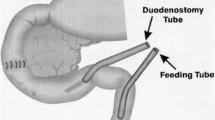Summary
Background: The greatest challenge in traumatized patients is the diagnosis of injuries to hollow visceral organs.
Methods: The diagnostic and therapeutic work-up of patients with bowel lacerations is reviewed.
Results: In most cases small bowel lacerations can be treated by suturing the defect, or by segmental resection. Treatment of large bowel injuries depends on the part of the colon involved and on concomitant peritonitis.
Conclusions: The last decade has seen a trend toward primary repair of bowel injuries. However, the final decision in the individual case depends on the extent of the peritonitis and the surgeon’s experience.
Zusammenfassung
Grundlagen: Das größte Problem bei traumatisierten Patienten ist die korrekte Diagnose einer Hohlorgansverletzung.
Methodik: Das diagnostische und therapeutische Vorgehen bei Patienten mit Darmverletzungen wird an Hand der Literatur besprochen.
Ergebnisse: Die meisten Dünndarmverletzungen werden durch simples Übernähen oder mit einer Segmentresektion behandelt. Das richtige Vorgehen bei einer Dickdarmverletzung hängt von dem Dickdarmabschnitt und der Begleitperitonitis ab.
Schlußfolgerungen: In dem letzten Jahrzehnt wird zusehends eine primäre Versorgung gefordert. Die Letztentscheidung für die individuelle Situation hängt jedoch vom Ausmaß der Peritonitis und der Erfahrung des behandelnden Chirurgen ab.
Similar content being viewed by others
References
Borlase B, Moore E, Moore F: The abdominal trauma index — a critical reassessment and validation. J Trauma 1990;30:1340–1344.
Boulanger BR, McLellan B: Blunt abdominal trauma. Emergency Medicine Clinics North America 1996;14:151–171.
Boulanger BR, Milzman DP, Rosati C, Rodriguez A: The clinical significance of acute hyperamylasemia after blunt trauma. Can J Surg 1993;36:63–69.
Bugis SP, Blair NP, Letwin ER: Management of blunt and penetrating colon injuries. Am J Surg 1991;163:547–550.
Burch JM, Martin RR, Richardson RJ, Muldowny DS, Mattox KL, Jordan GL: Evolution of the treatment of the injuried colon in the 1980s. Arch Surg 1991;126:979–984.
Chappuis C, Frey D, Dietzen C, Panetta T, Buechter K, Cohn I: Management of penetrating colon injuries. Ann Surg 1991;213:492–497.
Committee on Trauma, American College of Surgeons: Advanced Trauma Life Support. Chicago, The college, 1981.
Corman M: Colorectal trauma. In Corman M (ed): Colon and rectal surgery. Philadelphia, Lippincott, 1993, pp 245–251.
Cripps NP, Cooper GJ: Intestinal injury mechanisms after blunt abdominal impact. Ann R Coll Surg Engl 1997;79:115–120.
David A, Mollenhoff G, Josten C, Muhr G: Perineal injuries in complicated pelvic trauma. Swiss Surg 1996;1:4–9.
Espinoza R, Rodriguez A: Traumatic and nontraumatic perforation of hollow viscera. Surg Clin North Am 1997;77:1291–1304.
Flint LM, Vitale GC, Richardson JD, Polk HC: The injuried colon: relationship of management of complications. Ann Surg 1981;193:619–623.
Henneman PL, Marx JA, Moore EE, Cantrill SV, Ammons LA: Diagnostic peritoneal lavage:accuracy in predicting necessary laparotomy following blunt and penetrating trauma. J Trauma 1990;30:1345–1355.
Hirshberg A, Wall MJ, Allen MK, Mattox KL: Causes and patterns of missed injuries in trauma. Am J Surg 1994;168:299–303.
Hohenberger W, Mewes R, Köckerling F, Gall FP: Perforation of the small and large intestine. Chirurg 1987;58:561–570.
Levison MA, Walt AJ: Colonic trauma. In Fazio VW (eds): Current therapy in colon and rectal surgery. Toronto-Philadelphia, Decker 1990, pp 329–333.
Livingston DH, Tortella BJ, Blackwood J, Machiedo GW, Rush BF: The role of laparoscopy in abdominal trauma. J Trauma 1992;33:471–475.
McAnena OJ, Marx JA, Moore EE: Peritoneal lavage enzyme determinations following blunt and penetrating abdominal trauma. J Trauma 1991;31:1161–1164.
McKenney MG, Martin L, Lentz K, Lopez C, Sleeman D, Aristide G, et al: 1000 consecutive ultrasounds for blunt abdominal trauma. J Trauma 1996;40:607–610.
Metzger J, von Flue M, Babst R, Harder F: Small bowel injuries in blunt abdominal trauma-a diagnostic problem. Swiss Surg 1995;5:222–225.
Moore EE, Cogbill TH, Malangoni MA, Jurkovich GJ, Champion HR, Gennarelli TA, McAninch JW, Pachter HL, Shackford SR, Trafton PG: Organ Injury Scaling: Pancreas, Duodenum, Small Bowel, Colon and Rectum. J Trauma 1990;30:1427–1429.
Osler TM: The role of laparoscopy in abdominal trauma: a technique in search of an indication. Int Surg 1994;79:304–306.
Pfeifer J, Wexner SD, Reissman P, Bernstein M, Nogueras JJ, Singh S, Weiss E: Laparoscopic vs open colon surgery. Costs and outcome. Surg Endosc 1995;9:1322–1326.
Pommer S, Lange J: Der Stellenwert der Laparoskopie in der Diagnostik und Therapie des traumatisierten Abdomens. Wien klin Wschr 1995;107:49–53.
Rignault DP: Abdominal trauma in war. World J Surg 1992;16:940–946.
Shannon FL, Moore EE: Primary repair of the colon: when is it a safe alternative? Surgery 1985;98:851–857.
Sherck J, Shatney C, Sensaki K, Selivanov V: The accuracy of computed tomography in the diagnosis of blunt small bowel perforation. Am J Surg 1994;168:670–675.
Siegel J, Mason-Gonzales S, Dischinger P, Cushing B, Read K, Robinson R, et al: Safety belt restraints and compartment intrusions in frontal and lateral motor vehicle crashes: mechanisms of injuries, complications, and acute care costs. J Trauma 1993;34:736–758.
Smith L: Traumatic injuries. In Gordon PH, Nivatvongs S (eds): Principle and practice of surgery for the colon, rectum and anus. St. Louis/Missouri, Quality Medical Publishing 1992, pp 957–980.
Stewart RM, Fabian TC, Croce MA, Pritchard FE, Minard G, Kudsk KA: Is resection with primary anastomosis following destructive colon wounds always safe? Am J Surg 1994;168:316–319.
Wisner DH, Chun Y, Blaisdell FW: Blunt intestinal injuries. Keys to diagnosis and management. Arch Surg 1990;125:1319–1322.
Author information
Authors and Affiliations
Corresponding author
Rights and permissions
About this article
Cite this article
Pfeifer, J., Kronberger, L. & Uranüs, S. Injuries to hollow visceral organs. Acta Chir Austriaca 30, 338–340 (1998). https://doi.org/10.1007/BF02620090
Issue Date:
DOI: https://doi.org/10.1007/BF02620090




